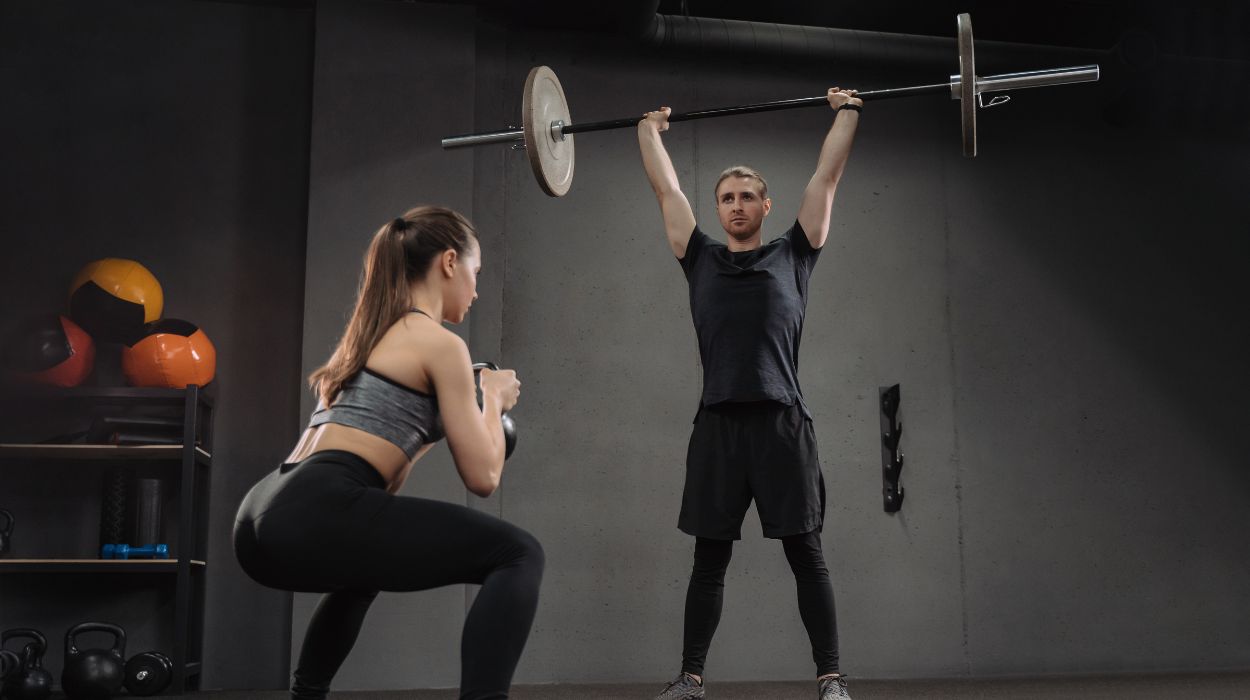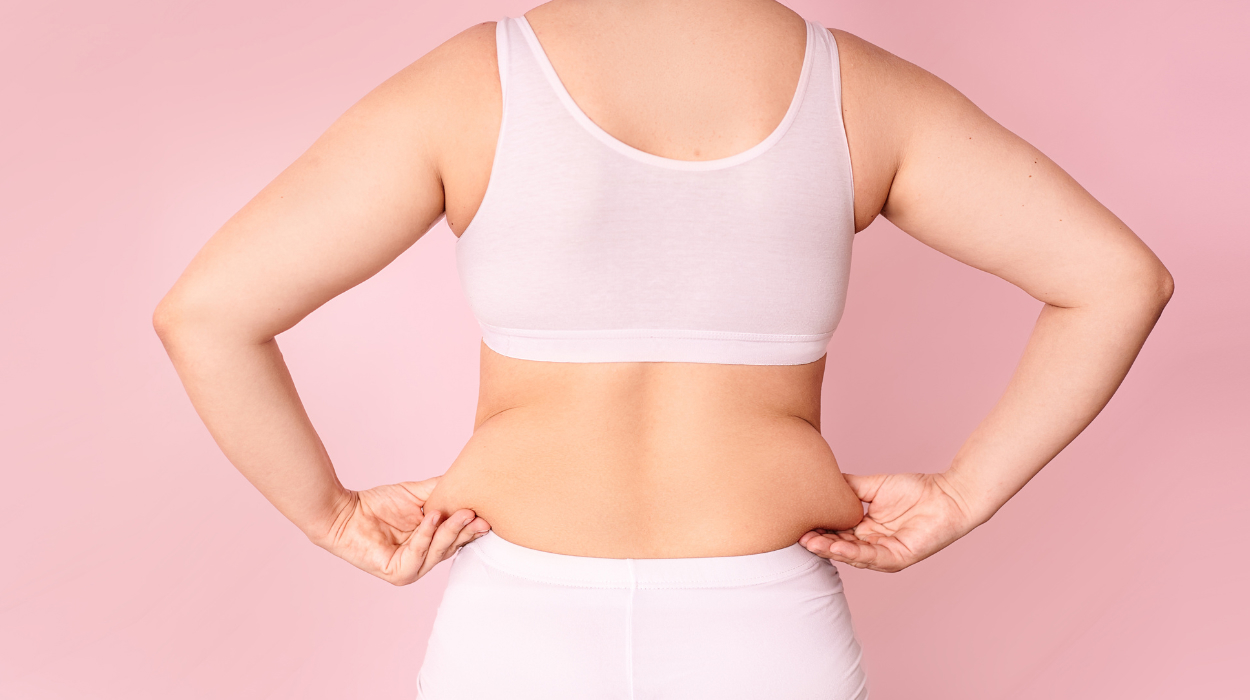It’s common for people to want to learn how to lose lower back fat. Fat in this area can make it difficult to find clothes that fit properly. It may also lead to love handles or a muffin top that so many people want to avoid.
You’ll need to be in a calorie deficit to get rid of body fat in the lower back. This occurs when you burn more calories than you consume. It’s actually necessary for fat loss. Staying away from processed foods while emphasizing those foods rich in lean protein and fiber will help your hypocaloric diet succeed with fewer calories to fuel excess fat accumulation.
You can achieve a calorie deficit to lose back fat by changing your diet, making positive lifestyle changes, and increasing strengthening exercises. Below are proven strategies for making these changes and enhancing your overall health.
Best Methods To Lose Lower Back Fat
If you want to learn how to lose lower back fat, you will need to be in a calorie deficit. You can achieve this with the following methods:
- Method 1: Learn the best exercises to get rid of lower back fat.
- Method 2: Change your diet to reduce calorie intake.
Best Exercises To Get Rid Of Lower Back Fat

If you’re looking for solutions for how to get rid of back fat, exercise can help. Keep in mind that you cannot achieve a spot reduction in fat from a specific location.
The back fat exercises below will not magically reduce fat in your lower back. Instead, they will help you to burn more calories for fat loss.
Lift Weights
Weight training exercises can help you to lose fat. A meta-analysis[1] of 58 different studies found that weightlifting reduces body fat percentage, enhances muscle growth, and reduces fat mass.
Adding weight and resistance training to your exercise routine can be a solution for reducing back fat. While you cannot choose where your body loses fat, some back exercises, like dumbbell rows and lat pull-downs, can make the area look more toned.
Ultimately, the benefits of weightlifting for fat loss are because of increased metabolic rate. A recent study[2] found that weight training boosts the resting metabolic rate by about 5%. Individual results will vary, but increases in RMR mean the body burns more calories per day at rest.
Practice High-Intensity Interval Training
High-intensity interval training is a suitable method for dropping fat. This type of exercise involves alternating intense bursts of activity with lower-intensity recovery periods.
You can follow an interval training routine by walking for four minutes and alternating this with one-minute sprint intervals. This type of workout has been found[3] to be effective for reducing belly fat since it decreases waist size.
Interval training is also effective[3] for overall fat loss. With time, it can help you to shed lower back fat.
One of the main benefits of interval training is that it burns fat with a 40% lower time commitment than training at a continuous intensity. This means it’s much faster to burn fat with interval training than with a moderate walk.
If you’re looking for fast back fat exercises, interval training could be the answer.
Focus On Running
There are various types of cardio exercises. If you’re choosing between running and cycling, running is probably a better option than cycling.
In the interval training study[3] mentioned above, running was beneficial for fat loss, but cycling was not. One study[4] found that a year of running an average of four times per week reduced overall body fat by 2.7%.
Study participants[4] ran an average of 14.4 kilometers, equal to about 9 miles, per week. This suggests that even small amounts of running can promote fat loss.
Take A Walk
Even moderate exercise, including walking, can help you to lose weight. In one study,[5] people who increased their walking lost significant amounts of weight and body fat. After three months, an increase of 1,000 steps per day led to just over half a pound of fat loss.
Since 1,000 steps a day can make a difference, larger increases in walking can be even more effective. Taking a walk each evening after dinner can increase your step count.
If you aim for 10,000 steps per day, you’ll significantly increase your calorie burn. This will get you closer to dropping that stubborn back fat.
Try Plyometrics
Plyometrics is a type of exercise training that uses speed and force to build explosive muscular power. Plyometrics training can improve your physical performance, skills, and ability to do different activities besides its benefits on losing weight.
Lower-body plyometric exercises involve jumping movements like skater jumps, jumping lunges, box drills, and high knees, which can promote fat burn. Upper-body plyometric exercises include ball throws, ball catches, push-ups, or kettlebell movements. You can even focus on your core by doing trunk plyometrics as crunches, Russian twists, seated or standing, or prone ball passes.
A recent study[6] found that plyometric exercises were less beneficial than high-intensity training. However, plyometrics did lead to reductions in body mass and waist size.
Based upon this finding, plyometrics could help you to achieve your fat loss goals. If you’re short on time, or you don’t have access to a gym, you can easily do these exercises at home. You can also try plyometrics a few days a week to change your routine.
Change Your Diet To Reduce Calorie Intake

In addition to exercising, changing your diet can help with back fat loss. You need to be in a calorie deficit to lose any type of fat. This means consuming fewer calories than you burn.
The strategies below can help you to reduce your calorie intake for a calorie deficit.
Calculate Your Deficit
Before making any changes to your diet, it’s important to learn the total calories burned per day. This will help you to determine how many calories you can eat and be in a calorie deficit.
While they are not 100% accurate, an online calories burned calculator can estimate how many calories you burn each day. These calculators consider your age, weight, height, gender, and activity level.
Once you’ve entered this information, the calculator will estimate your total daily calorie burn. From there, reduce your calorie intake, so you should consume less than you burn.
A general guideline from expert research[7] is to be in a deficit of 500 to 750 calories a day. This would mean that if you burn 2,200 calories per day, you should eat 1,450 to 1,700 for weight loss.
It’s probably best to stick with a smaller deficit because large deficits aren’t sustainable. You might lose some weight, but sticking to the large deficit will be difficult.
Fill Your Plate With Protein
Protein can be beneficial when trying to stay in a calorie deficit. With your calorie needs in mind, add some protein to your diet to keep yourself feeling full.
Protein is satiating, meaning it will leave you feeling fuller. This makes you less likely to overeat and more likely to remain in your calorie deficit for losing lower back fat.
Clinical research[8] has confirmed that protein is beneficial for weight loss because it increases feelings of fullness. You’ll likely eat less over time with a higher protein intake.
If you stick to consistently eating a high-protein diet, you will lose lower back fat over time.
Consume More Fiber
Increasing fiber intake is also beneficial for staying full and remaining in a calorie deficit.
Fiber is so beneficial that research[9] has determined that increasing fiber intake by 10 grams a day can lead to significant fat loss.
One study[10] found that participants consuming high-β-glucan barley and rice twice a day with their regular meals lost both weight and fat. Study authors stated that these effects likely occur because β-glucan, which is a soluble fiber, slows digestion and emptying of the stomach.
To take advantage of this benefit, include high-fiber foods, like fruits, vegetables, whole grains, and beans in your diet. Making a habit out of eating these foods can lead to back fat loss over time.
Increase Fruit And Vegetable Intake
Filling your plate with more fruits and vegetables is another method for sticking with a calorie deficit. Consuming more fruits and vegetables is a sustainable way to reduce your calorie intake.
Studies[11] have confirmed that fruit and vegetable intake can play an important role in weight loss. This is especially true when people consume whole produce.
The fiber and water content in whole fruits and vegetables can keep you full and satisfied so that you eat less. This makes these foods beneficial for staying in a deficit when you’re trying to drop back fat.
Try Intermittent Fasting
Intermittent fasting can help you to stay in a deficit for back fat loss. This method reduces your calorie intake by restricting eating to specific windows of time.
If you try intermittent fasting, you will pick an eating window and a fasting window each day. For example, you could choose an eating window of 10 a.m. to 6 p.m. and then fast from 6 p.m. to 10 a.m. the next day.
By limiting your eating to a certain window, you’ll naturally consume less over the course of the day. This allows you to remain in a deficit, perhaps without even realizing it.
There are different ways to do intermittent fasting, but the research[12] confirms this method works. Studies have shown that intermittent fasting improves blood sugar control and reduces body mass index.
What Is Lower Back Fat & What Causes It?
Lower back fat, as the name suggests, refers to fat deposits in the lower back region. These deposits are sometimes called love handles. People may also refer to this region as the “muffin top” if extra belly fat accompanies lower back fat.
Ultimately, a person develops extra back fat when they gain weight. Numerous factors contribute to weight gain. Underlying all of these factors is an excess calorie intake. Put simply, when people consume more calories than they burn, they will gain fat.
Several factors can contribute to weight gain and accumulation of back fat. This can include poor diet, lack of exercise, stress hormones, poor sleep, poor nutrition, and medical problems. Research[13] has shown that people over 30 years of age and individuals with diabetes and high blood pressure are more likely to carry fat in the central region.
Women are also more likely[13] to carry fat in this area. This leads to many searches for how to lose back fat for females. Fortunately, the strategies discussed here can be just as effective for women.
Final Thoughts
If you’re looking for advice on how to lose back fat, you can be successful by exercising and changing your diet. There are no specific exercises for losing back fat, but exercise can increase calorie burn and promote fat loss.
Changes to your diet can also help you lose back fat. By reducing your calorie intake, you’ll be in a calorie deficit. This is necessary for any type of fat loss.
You do not have to try all of the strategies discussed here. However, it’s important to select a few that help you change your diet and exercise habits.
Some people may also consider using fat-burning supplements, but these are not magic pills. They can only provide help, for instance, decreasing appetite and making it easier to be in a calorie deficit. But you should always consult your doctor before using any kind of supplement.
Frequently Asked Questions
Weight gain, including accumulation of lower back fat, occurs when you consume more calories than you burn. Factors like overeating, lack of exercise, and stress can contribute.
The fastest way to lose lower back fat is to eat in a calorie deficit for weight loss and to target excess body fat through cardio and strength training. You can also exercise to increase overall calorie burn and promote a calorie deficit.
You cannot expect a spot reduction in lower back fat. Exercising to increase muscle mass and burn more calories will help with overall fat loss. Over time, you will lose back fat.
Cardio exercises do not specifically target back fat. However, doing cardio can increase your calorie burn and help rid you of excess fat. This will make it easier to be in a calorie deficit for fat loss.
 Evidence Based
Evidence Based
